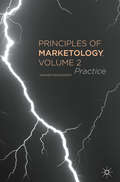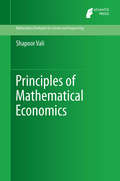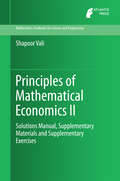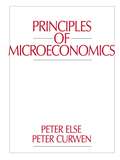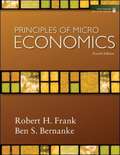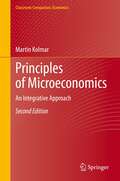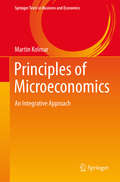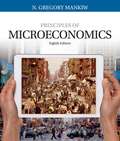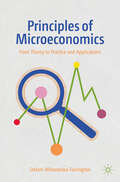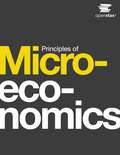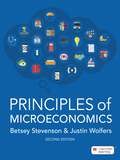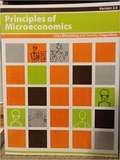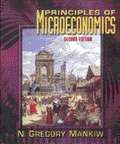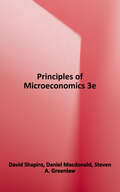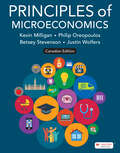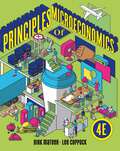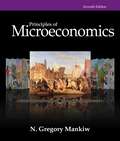- Table View
- List View
Principles of Marketology, Volume 2
by Hashem AghazadehBusinesses today operate in a more complex and turbulent environment and face intense competition. To be successful, businesses must intelligently understand and deal with their changing environment and market. In this book, Hashem Aghazadeh introduces marketology as a market-related system that enables businesses to achieve competitive success through providing superior value to their key stakeholders. In this regard, the hyper-function of marketology supports business executives to make effective market-related decisions and take efficient market-related actions throughout the organization. Principles of Marketology, Volume 2: Practice concentrates on how to deploy and practice marketology architecture all over the organization. Marketology accomplishes business performance and success based on its organizational design and behavior. In this regard, marketology contributes through generation, dissemination, and exploitation of market intelligence and insight. The future of marketology is contemplated and an integrated guideline of practicing marketology is provided.
Principles of Mathematical Economics
by Shapoor ValiUnder the assumption of a basic knowledge of algebra and analysis, micro and macro economics, this self-contained and self-sufficient textbook is targeted towards upper undergraduate audiences in economics and related fields such as business, management and the applied social sciences. The basic economics core ideas and theories are exposed and developed, together with the corresponding mathematical formulations. From the basics, progress is rapidly made to sophisticated nonlinear, economic modelling and real-world problem solving. Extensive exercises are included, and the textbook is particularly well-suited for computer-assisted learning.
Principles of Mathematical Economics II
by Shapoor ValiThis manual provides solutions to approximately 500 problems appeared in various chapters of the text Principles of Mathematical Economics. In some cases, a detailed solution with the additional discussion is provided. At the end of each chapter, new sets of exercises are given.
Principles Of Micro-economics
by Ryan C. Amacher Richard J. Sweeney Lloyd M. ValentineIn the early 1970s, the economics profession and the teachers of introductory economics courses went through an exhaustive search for "relevance," in large part because students demanded it. Unfortunately, this search for relevance produced a large number of "cute" applications aimed superficially at catching students' (or instructors') eyes. <P><P>We learned, for example, that supply and demand can be applied to markets for illegal drugs and marketable sex. The results of this rush toward relevance, however, were predictable. Some students were offended, others were amazed, and many were bored. Instructors for the most part then fell back on the tested (and familiar) ways of approaching the subject of economics. <P><P>Our goal in writing this book has been to show students the relevance of the economic approach as it applies both to important real-world situations and to economic policymaking. This is not easily accomplished. Today's students are not deceived by slick marketing techniques. If the economic approach is a relevant way to approach social and political problems, students must be convinced through application and example. This book is intended to accomplish that difficult task.
Principles of Microeconomics
by Ben Bernanke Kate Antonovics Ori Heffetz Robert FrankPrinciples of Microeconomics focuses on seven core principles to produce economic naturalists through active learning. By eliminating overwhelming detail and focusing on core principles, students from all backgrounds are able to gain a deeper understanding of economics. Focused on helping students become "economic naturalists," people who employ basic economic principles to understand and explain what they observe in the world around them. COVID-19 pandemic content, analysis, and examples further engage students. With engaging questions, explanations, exercises and videos, the authors help students relate economic principles to a host of everyday experiences such as going to the ATM or purchasing airline tickets. Throughout this process, the authors encourage students to become "economic naturalists." Author developed Learning Glass concept overview videos and Worked Problem videos give students an overview of challenging and important concepts. With new videos and engagement tools in Connect, like Application-Based Activities, alongside SmartBook''s adaptive reading experience, the 8th edition enables instructors to spend class time engaging, facilitating, and answering questions instead of lecturing on the basics.
Principles Of Microeconomics
by Karl Case Ray Fair Sharon OsterIntended primarily for the one semester principles of microeconomics course, this text also provides practical content to current and aspiring industry professionals.
Principles of Microeconomics
by Peter Curwen Peter ElseElse and Curwin make an effort to keep the student in touch with recent developments by including such topics as bargaining search, contestable markets and voting behaviour...it will certainly appeal to those who wish to keep economic theory accessible to as wide a range of students as possible.' Times Higher Education Supplement This clear, concise introduction to intermediate microeconomics is essential reading for students with previous knowledge of economic principles. Geared to the standard year's course in universities and polytechnics, the treatment in this text reinforces the student's understanding of familiar topics and facilitates assimilation of new material.
Principles Of Microeconomics
by Robert H. Frank Ben BernankeA book that encourages students become "economic naturalists," people who employ basic economic principles to understand and explain what they observe in the world around them.
Principles of Microeconomics: An Integrative Approach (Classroom Companion: Economics)
by Martin KolmarThis textbook provides a comprehensive and unique introduction to modern microeconomics. It adopts an integrative approach, positioning the main findings of economics in a broader context. It critically reflects on theories from a philosophical standpoint and compares them to approaches found in the social sciences, while at the same time highlighting the implications for the design of legal systems and business practices.Intended for undergraduate students, the book presents brief examples and comprehensive case studies to help them grasp the real-world implications of the theories. As such, it is suitable for an applied, yet technically precise approach to teaching microeconomics, as well as for a critical review of the economic mainstream. Starting from the question as to why and how societies organize economic activity, it analyzes the potential and limitations of various types of market with regard to alleviating scarcity and achieving distributive objectives, from an institutional perspective.This second edition systematically expands on decision theory by including chapters on traditional decision theory under risk and uncertainty, and on behavioral economics, as well as a chapter presenting findings from the neurosciences, evolutionary psychology, and narrative psychology. Furthermore, there are theoretical additions, along with updated case studies and examples – from trade wars to pandemics and the climate crisis.A new edition of the companion workbook features a wealth of exercises, ranging from basic multiple-choice questions to challenging mathematical problems and case studies, is also available.
Principles of Microeconomics: An Integrative Approach (Springer Texts in Business and Economics)
by Martin KolmarThis text provides a comprehensive and unique introduction to modern microeconomics. It pursues an integrative approach by putting the main findings of economics into a broader perspective; theories are critically reflected on from a philosophical standpoint and by comparing them to approaches found in the social sciences, while implications for the design of the legal system and business practices are highlighted throughout. In addition, the book presents brief examples and comprehensive case studies to facilitate an understanding of the theories’ real-world implications.Starting from the question as to why and how societies organize economic activity, the book adopts an institutional perspective to analyze the potential and limitations of different market types with regard to alleviating scarcity and achieving distributive objectives.It not only covers traditional rational-choice models, but also systematically introduces readers to important findings from behavioral economics and psychology.A companion workbook is available which features a wide variety of exercises, ranging from basic multiple-choice questions to challenging mathematical problems and case study scenarios.
Principles Of Microeconomics
by N. Gregory MankiwNow readers can master the principles of microeconomics with the help of the most popular introductory book in economics today that is widely used around the world -- Mankiw’s PRINCIPLES OF MICROECONOMICS, 8E. <P><P>With its clear and engaging writing style, this book emphasizes only the material that readers are likely to find most interesting about the economy, particularly if they are studying economics for the very first time. <P><P>Reader discover interesting coverage of the latest relevant microeconomic developments with real-life scenarios, useful economic facts, and clear explanations of the many ways microeconomic concepts play a role in the decisions that individuals make every day.
Principles of Microeconomics: From Theory to Practice and Applications
by Stefani Milovanska-FarringtonThis textbook offers a comprehensive overview of microeconomics, featuring teachable and applicable approaches to core concepts. It includes fresh examples and applications to help students understand and apply opportunity cost, choice theory, and more to their own world. Throughout the book, there are practice problems with step-by-step solutions that help students better understand the topics covered. Sections provide scenarios to help students analyze consumer choices as well as the decisions of firms. Readers will learn how to evaluate the impact of microeconomic policies and how to perform equilibrium analysis. The author publishes digital worksheets with questions based on recent news stories that readers can use as they work through the book: https://econstefani.substack.com/. The book, combined with these free materials, introduces new and fresh approaches to help students apply fundamental concepts to the world around them. The resulting book is a valuable learning tool that highlights microeconomic principles for a new generation of learners.
Principles of Microeconomics
by OpenStaxPrinciples of Microeconomics covers the scope and sequence for a one-semester economics course. The text also includes many current examples, including; the Keystone Pipeline, Occupy Wall Street, and debates over the minimum wage. The pedagogical choices, chapter arrangements, and learning objective fulfillment were developed and vetted with feedback from educators dedicated to the project. The outcome is a balanced approach to economics and to the theory and application of economics concepts. Current events are treated in a politically-balanced way, as well.
Principles of Microeconomics
by Libby Rittenberg Timothy TregarthenToday we are excited to introduce Libby Rittenberg and Timothy Tregarthen’s Principles of Microeconomics. The authors teach economics as the study of “choice “ by providing students with an accessible, straightforward overview of economics. This text combines the clarity and writing of Tregarthen's seminal periodical "The Margin" with great teaching insights. Rittenberg and Tregarthen help students to understand how real individuals actually work with economics. In this new book, the authors illustrate the practicality and relevance of economics with a variety of new illustrations and insights. The authors take a three-pronged approach to every concept: (1) the concept is covered with a “Heads Up” to ward off confusion, (2) a “You Try It” section makes sure students are staying on top of the concept and (3) a “Case and Point” section that uses a real-world application to harness the concept in reality.
Principles of Microeconomics
by Libby Rittenberg Timothy TregarthenIn Principles of Microeconomics, the authors explore how political outcomes of events, such as Brexit and the election of Donald Trump, affect economic policies and economic outcomes. Throughout the last decade, economists have received the public’s attention, and the authors saw an opportunity to share economic principles and thinking in a way that emphasizes their relevance in today’s world.
Principles of Microeconomics
by Betsey Stevenson Justin WolfersStevenson/Wolfers is built around the idea that ‘every decision is an economic decision’. It is the perfect choice for Principles of Economics courses and for economics majors and nonmajors alike.
Principles of Microeconomics: Economics and the Economy
by Timothy TaylorThis fourth edition teaches the tools and principles that are standard for introductory economics, in a way that students can see the applications for the U.S. and world economy. The facts, anecdotes, and explanations have been scrutinized and updated throughout. Some new examples include high-profile topics at key points, like using the rise in demand for sand from fracking for principles of supply and demand, or explaining how the Federal Reserve is now conducting monetary policy by varying the interest rate paid on bank reserves. Tim Taylor has provided a complete updating of numerical graphs and statistics. In addition, this book has been structured since the first edition to mix in international topics and to consider product, labor, and capital markets side by side, which helps it apply easily to so many of the topics now in the news: effects of globalization on growth and labor markets, budget deficits, the minimum wage, health insurance, and many more.
Principles of Microeconomics 2.0
by Libby Rittenberg Timothy TregarthenFlat World Knowledge is honored to publish Version 2.0 (an orginal re-launch) of Tim Tregarthen's wonderful principles of microeconomics book, and proud to bring Tim's incredible talents as a teacher back to life so future generations of students can continue to learn from him.
Principles of Microeconomics (2nd Edition)
by N. Gregory MankiwIn this textbook, Mankiw's conversational writing style helps in presenting the politics and science of economic theories to tomorrow's decision-makers. The book is intriguing students to apply an economic way of thinking in their daily lives.
Principles of Microeconomics (2nd Edition)
by Timothy TaylorA textbook that is rooted to help students perform well in introductory economics and acquire the basic tools to deal with economics.
Principles of Microeconomics, 3e
by David Shapiro Daniel Macdonald Steven A. GreenlawPrinciples of Microeconomics 3e covers the scope and sequence of most one-semester introductory microeconomics courses. The third edition takes a balanced approach to the theory and application of microeconomics concepts. The text uses conversational language and ample illustrations to explore economic theories and provides a wide array of examples using both fictional and real-world applications. The third edition has been carefully and thoroughly updated to reflect recent developments, as well as to provide a deeper background in diverse contributors and their impacts on economic thought and analysis. For example, the third edition highlights the research and views of a broader group of economists. This is the official print version of this OpenStax textbook. OpenStax makes full-color hardcover and B&W paperback print copies available for students who prefer a hardcopy textbook to go with the free digital version of this OpenStax title. The textbook content is exactly the same as the OpenStax digital book. This textbook is available for free download at the OpenStax dot org website, but as many students prefer to study with hardcopy books, we offer affordable OpenStax textbooks for sale through Amazon as well as most campus bookstores.
Principles of Microeconomics (4th edition)
by N. Gregory MankiwEconomics combines the virtues of politics and science. It is, truly, a social science. Its subject matter is society-- how people choose to lead their lives and how they interact with one another. But it approaches the subject with the dispassion of a science. By bringing the methods of science to the questions of politics, economics tries to make progress on the challenges that all societies face. This book is devoted more to applications-- and less to formal economic theory. Most chapters include case studies illustrating how the principles of economics are applied. Although the principles of economics are timeless, the application of those principles changes over time as events unfold and as policymakers consider new initiatives. To keep the study of economics fresh and relevant for each new cohort of students, teachers of economics must constantly update their courses. This new edition contributes to that effort by including dozens of new case studies and boxes.
Principles of Microeconomics Canadian Edition
by Kevin Milligan Philip Oreopoulos Betsey Stevenson Justin WolfersPrinciples is built around the idea that “every decision is an economic decision.” It is the perfect choice for Canadian principles of economics courses and for economics majors and nonmajors alike.
Principles of Microeconomics (Fourth Edition)
by Dirk Mateer Lee CoppockMateer and Coppock Make Economics for Everyone Drawing on their extensive teaching experience in the classroom and online, Mateer and Coppock continuously innovate to address the changing teaching and learning challenges faced by instructors and students. The Fourth Edition introduces new scaffolded learning pedagogy with a Norton Illumine Ebook as well as revised InQuizitive and Smartwork activities that provide personalized support and build problem-solving skills. New relevant and relatable examples ensure that students understand how their lives are influenced by economics, and rich Norton Teaching Tools resources help instructors connect with students before, during, and after class. This purchase offers access to the digital ebook only.
Principles Of Microeconomics (Seventh Edition)
by N. Gregory MankiwWith its clear and engaging writing style, PRINCIPLES OF MICROECONOMICS, Seventh Edition, continues to be one of the most popular books on economics available today. Mankiw emphasizes material that you are likely to find interesting about the economy (particularly if you are studying economics for the first time), including real-life scenarios, useful facts, and the many ways economic concepts play a role in the decisions you make every day.
